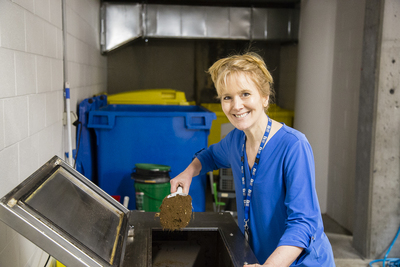A Day in the Life of Ros Morgan

Every day nurses, midwives and carers see examples of the link between people’s wellbeing and health and their environment. It could be an older person with environmental exacerbation of respiratory diseases or a pregnant woman affected by the heat. Six years ago, ANMF members asked their union to become more involved in climate change and environmental issues policy debate. The creation of Ros’s role was one of the ANMF’s many responses. Ros is an intensive care nurse with a contagious passion for sustainability practice in healthcare services.
06:40 My train commute gives me a chance to catch up on emails. I also check inquiries on the ANMF (Vic Branch) Green Nurses and Midwives Facebook page. It’s a closed group with more than 800 active members sharing ideas and information about successful sustainable projects in their health services.
08:00–09:00 I arrive in the office and start answering member inquiries. Nurses and midwives are so conscious of the waste health care generates. I get asked to clarify what clinical waste goes where, what waste goes in hospital commingle and PCV, Kimguard and metal instrument diversion. Another hot topic is ‘How do I set up a green team?’. I read newsletters from The Climate and Health Alliance and Global Green and Healthy Hospitals.

09:00–10:30 I meet with the ANMF events team. We’re finalising the speakers for the 2019 ANMF (Vic Branch) Health and Environmental Sustainability Conference. I’m excited about the nurses and midwives who will showcase their creative interventions turning surgical huck towels into boomerang bags, including surgical blue wrap in urban survival kits and removing plastic straws from clinical settings. Every action counts! Every second year we package this one-day conference with the biennial Nurses and Midwives Wellness Conference.
10:30–12:30 I travel up to the Department of Health and Human Services for the Waste Project Working Group meeting. Reinventing the wheel is a frustrating waste of time when nurses and midwives are working hard to meet all our clinical responsibilities. The role of this group and the department’s Waste Education Officer Rachel McConville is to develop multiple resources to clarify available waste segregation streams.
Another source of frustration is the application of the clinical waste guidelines; for example, can a needless syringe go into landfill or is it always considered a sharp? We’re developing a new FAQ document to clarify issues around syringes, pharmaceutical containers and blood rules in Victoria.
12:30–13:30 Back in the office I turn my eye to the revision of the Environmental Protection Authority Victoria’s clinical waste guidelines and a draft supporting document. This is part of my work with a subgroup working with EPA Victoria and the Department of Health and Human Services.
After a quick lunch in the staff hub, I peep in the bins to see how ANMF staff are going with waste segregation. I assure you I’m not the only bin checker out there! If I identify problem areas I can feed back into our education. All clear today!
Our industrial composter dehydrates 20 kilograms of organic waste daily from the ANMF building, which is made available for staff to take home for their gardens.

13:30–16:00 Twice a year we run ‘Nursing for the Environment’ to help nurses and midwives develop a practical plan to introduce or improve sustainable practices at their workplace. I’m currently rewriting the course so we can run two new programs — beginners and advanced.
16:00–17:00 I finish off an abstract for an international conference to share many of Victoria’s successes with similar-minded nurses and midwives across the globe.
Practical sustainabilityGet together with your colleagues and get practical. Here’s some of Ros Morgan’s favourite projects to get you started. She says, “Start where you are, use what you have, do what you can.” Surgical blue wrap fashion showTeam up with some colleagues who are handy with a sewing machine and create some catwalk creations. Events like this get people thinking about the re-use possibilities. Members of the Green Nurses and Midwives Facebook Group have used this blue wrap, also known as Kimguard, to create boomerang bags and camping kits.
Rugs for the homelessDid you know that non-bio-degradable soft plastics and bread bags can be cut into strips and crocheted into insulating floor mats? As environment sustainability officer for Monash Health, Morgan coordinated a project which made 27 adult-sized rugs for the homeless using 20,000 plastic bread bags from the Monash Medical Centre’s Clayton kitchen. Green mascotKeen to find ways to engage, Morgan purchased a Kermit the Frog costume, which she uses to make environmental education a bit more fun. The amphibian Muppet has made an appearance at various events including handing out environmentally themed colouring in pictures to bed-bound children. It seems kids aren’t the only ones who like dress-ups! 3D displaySet up a display table to provide a visual resource of what waste goes where and what waste can be diverted from landfill in healthcare waste. Include things like commingle recycling, surgical blue wrap, PVC, single-use metal instruments, phones and printer cartridges. Create a 3D bin to teach waste segregation. Morgan found an old set of collapsible camping shelves from a garage sale and made a heavy card front with peep holes cut into it. This made a great 3D model for displaying appropriate waste segregation.
|
Some patients wait 6 years to see a public hospital specialist. Here's how to fix this
Australian research spanning more than a decade suggests there are ways to reduce waiting lists...
Reusing medical equipment is good for the planet. But is it safe?
A new study tested replacing just one kind of item — single-use absorbent pads, known...
Stewardship and sustainability: environmentally minded medical products
Australia's health sector produces twice as much carbon emissions as aviation. But with...






![[New Zealand] Transform from Security Awareness to a Security Culture: A Vital Shift for SMB Healthcare — Webinar](https://d1v1e13ebw3o15.cloudfront.net/data/89856/wfmedia_thumb/..jpg)
![[Australia] Transform from Security Awareness to a Security Culture: A Vital Shift for SMB Healthcare — Webinar](https://d1v1e13ebw3o15.cloudfront.net/data/89855/wfmedia_thumb/..jpg)




